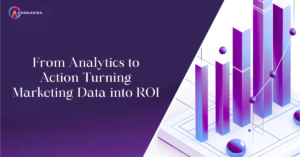In the fast-changing world of marketing, data-driven strategies have become a key way to improve campaigns and achieve measurable results. Businesses no longer rely solely on instinct or past routines to make decisions. Now, real-time data, analytics, and artificial intelligence (AI) allow marketers to make smarter choices, customize experiences, and boost ROI. By 2025, using analytics in marketing will not just be an advantage; it will be necessary.
This blog discusses the principles and benefits of data-driven marketing, how analytics impacts campaign execution, and how Codearies helps forward-thinking brands harness this power for growth.
What Is Data-Driven Marketing?
Data-driven marketing involves using insights from customer interactions, analytics platforms, and third-party sources to shape marketing strategies. Marketers examine consumer motivations, preferences, and behaviors, then create personalized campaigns designed to deliver the best return
Key hallmarks of data-driven marketing include:
- Targeted messaging and segmentation
- Personalized multi-channel experiences
- Decision-making rooted in hard evidence
- Continuous optimization based on real-time feedback
The Benefits of Data-Driven Marketing
Businesses that adopt data-driven approaches consistently outperform their competitors. Here are the main benefits:
- Deeper Customer Understanding: Analytics show what customers want, which campaigns work, and where obstacles exist—allowing brands to adjust their offerings precisely.
- Personalized, Relevant Campaigns: Rather than sending out blanket messages, companies can deliver content and offers tailored to individual profiles, preferences, and behaviors. Personalized messaging increases engagement, conversion, and retention.
- Better Resource Allocation and ROI: By identifying which channels, creatives, and tactics perform best, marketers can invest more in effective strategies and cut spending on those that aren’t working.
- Increased Agility and Speed: Automated dashboards and real-time analytics enable teams to pivot quickly, stopping, scaling, or adjusting campaigns for the best impact.
- Improved Customer Retention: Happy, well-understood customers become loyal supporters. Data-driven marketing fosters lasting relationships through relevant interactions at every stage.
- Predictive Power: Advanced analytics and AI help forecast trends, anticipate customer needs, and keep brands ahead of market shifts.
- Competitive Edge: Quick, data-driven decision-making allows agile organizations to outpace slower, guess-based competitors.
- Reduced Costs: Efficiency rises as spending focuses only on what delivers value and results.
A 2025 study found that companies using advanced analytics see marketing ROI five to eight times higher than those that do not.

The Data-Driven Marketing Process
1. Data Capture and Integration
Marketers gather data from various sources, including websites, apps, CRM systems, social media, email campaigns, transactions, and external feeds. Integration platforms and cloud-based data lakes merge this information, breaking down silos and providing a single source of truth.
2. Analysis and Segmentation
With rich datasets in hand, analytics tools categorize users based on demographic, behavioral, psychographic, and situational factors. AI and machine learning power predictive models, enabling brands to:
- Identify high-value or at-risk customer groups
- Uncover new audience segments
- Prioritize campaigns and interventions
3. Campaign Execution and Personalization
Instead of a “one-size-fits-all” approach, campaigns are customized. Content, timing, channel, and offers adapt dynamically based on the latest data and predicted preferences.
4. Real-Time Optimization
Performance data streams in continuously via dashboards. AI and analytics pinpoint what works, suggest changes, and sometimes even automatically adjust creatives, targeting, or budgets for the best outcomes.
5. Measurement and Attribution
Advanced attribution modeling clarifies the real impact of every touchpoint, allowing brands to refine their strategies, invest in winning ideas, and phase out what isn’t effective.

2025 Trends in Data-Driven Marketing
- AI and Real-Time Analytics: Instant processing and automation enable campaign adjustments in real time.
- Hyper-Personalization: Predictive analytics and machine learning customize user experiences down to the individual level.
- Omnichannel Attribution: Tracking the complete customer journey across web, app, in-store, and emerging channels.
- Data Privacy by Design: With GDPR/CCPA and cookieless tracking, savvy marketers rely on first-party data, transparent consent, and ethical analytics.
- Immersive Measurement: New tools assess not just clicks and opens, but also sentiment, engagement depth, and even real-time emotional responses.
How Codearies Accelerates Data-Driven Marketing Success
At Codearies, we help brands maximize the potential of analytics-driven marketing. We support you in building the infrastructure, skills, and culture needed for continuous growth. Here’s how:
- Data Infrastructure Design: Integrating all relevant data sources into unified dashboards, reducing confusion and silos.
- Advanced Analytics Solutions: Custom dashboards, reporting, campaign tracking, and AI-driven modeling tailored to your goals.
- Personalization Engines: Data-driven content and offer customization for web, email, mobile, and paid media channels.
- Predictive and Real-Time Tools: Implementing platforms for on-demand insights, trigger-based marketing, and quick campaign optimization.
- Privacy and Compliance: Building GDPR, CCPA, and global compliance into every system to enhance trust and legal security.
- Team Training and Strategy: From tool adoption to KPI selection, we upgrade your marketers’ skills to extract real value from analytics.
With Codearies as your analytics partner, you don’t just look at numbers; you turn data into actionable insights and profitable results.
Frequently Asked Questions (FAQ)
What’s the difference between traditional and data-driven marketing?
Traditional marketing relies more on instinct, fixed demographics, and past habits. Data-driven marketing uses real-time analytics, predictive modeling, and ongoing feedback to customize and enhance campaigns.
How quickly can brands see results with data-driven strategies?
Improvements in efficiency, targeting, and ROI can start within weeks of implementing data-driven strategies, with advanced automation and predictive analytics providing increasing benefits over time.
Can small businesses leverage analytics as effectively as enterprises?
Absolutely! Affordable analytics platforms and user-friendly dashboards make powerful data-driven marketing available for businesses of all sizes. Codearies customizes solutions to fit your needs.
How does Codearies ensure data privacy and compliance?
We design solutions with built-in consent, anonymization, and strong security, so every analytics initiative meets local and global data regulations.
What support does Codearies offer beyond implementation?
We provide ongoing support, performance enhancement, training, and analytics reviews—helping your marketing team make the most of insights and results as your business grows.







